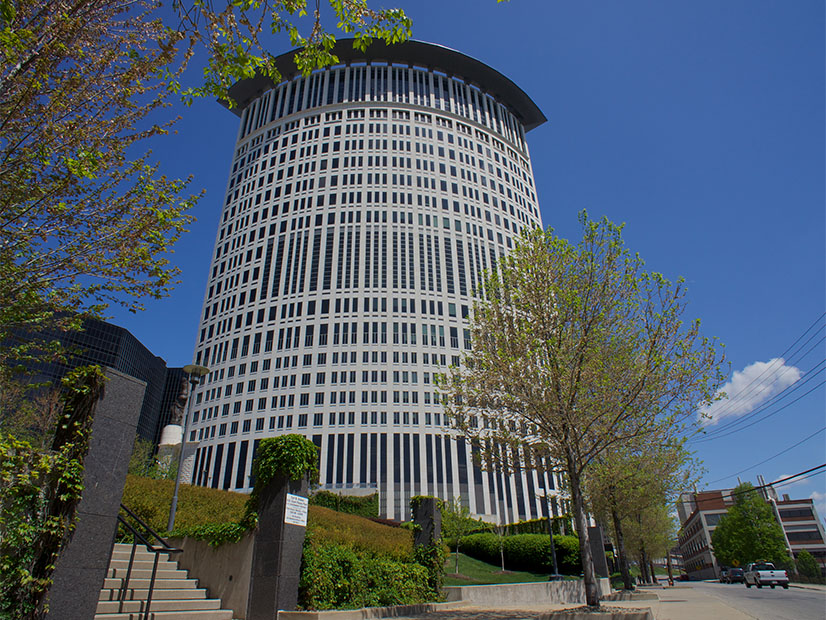
The U.S. General Services Administration is doubling down on its efforts to slash greenhouse gas emissions from federal buildings with recent announcements aimed at both procuring carbon-free energy and testing out new energy-efficient, low-carbon technologies.
On July 31, GSA released its long-awaited solicitation for more than 1.1 million MWh of carbon-free electricity (CFE) per year ― half of it matched hour by hour 24/7 with demand ― to power a significant chunk of federal buildings across five Mid-Atlantic and Midwestern states within the PJM footprint.
On Aug. 1, the agency partnered with the Department of Energy to put out a request for information on emerging energy efficiency and low-carbon technologies that can be tested in federal buildings through GSA’s Center for Emerging Building Technologies (CEBT) program.
The RFI kicks off the second round of the initiative, which is funded with $30 million from the Inflation Reduction Act. On July 18, GSA and DOE announced the selection of 17 emerging technologies that will be installed and evaluated in federal buildings with $9.6 million of the IRA money.
The selected technologies include low-carbon cement (Sublime Systems and C-Crete Technologies), cold climate heat pumps and very high efficiency HVAC (Trane and the Institute for Market Transformation), geothermal retrofits (Brightcore Energy), and building-integrated solar (Vitro Architectural Glass and Oldcastle Building Envelope).
With jurisdiction over 8,800 federally owned or leased buildings, GSA has become the de facto leading edge of President Joe Biden’s efforts to slash emissions from federal buildings and vehicles through a range of public-private partnerships.
In Executive Order 14057, issued in December 2021, Biden called on the government to lead by example and use its massive buying power to stimulate demand for clean energy and energy-efficient, low-carbon technologies. The EO set ambitious targets for federal buildings to run on 100% CFE by 2030 and cut their greenhouse gas emissions 50% by 2032 and reach net zero by 2045.
To hit those goals, GSA is looking for contractors who can provide 100% CFE for 182 accounts at locations in Delaware, Maryland, New Jersey, Ohio and Pennsylvania under 10-year, fixed-price contracts. The solicitation does not identify the specific federal buildings that could be powered with CFE, noting only, for example, that five GSA accounts in Baltimore Gas and Electric’s service territory will require around 40 million kWh of CFE per year.
Another core requirement is that a certain amount of the power provided — generally about 35% for each state — should be “bundled CFE,” meaning “the original associated energy attributes have not been separately sold, transferred or retired.”
Energy attribute certificates (EACs) are issued to verify that 1 MWh of clean energy has been generated and fed into the grid. Renewable energy credits (RECs) from solar or wind projects are the most familiar form of EACs.
“Unbundled” RECs or EACs can be sold separately from the power that produced them. Solar installers may sell them to bring down the costs of an installation, and utilities or other companies often buy them to meet state-level clean energy mandates, passing on the cost to customers through increased rates.
For GSA, the bundled EAC requirement sends a clear signal that the EACs for any clean electricity used to power federal facilities should not be sold for profit or used as a substitute for putting additional, clean energy on the grid.
But the GSA solicitation also recognizes that sufficient bundled CFE may not be available initially and allows contractors to set out a schedule of “milestones” at which they will provide increasing amounts of the power. The schedule and commitments then will be incorporated into their contracts.
The solicitation process will be broken into two phases. The first will focus on contractors’ experience and technical competence to deliver the power, and the second will solicit the actual bids. Deadlines are Aug. 30 for the first phase and Sept. 30 for the second. GSA intends to complete contracts by the end of 2024, with delivery of CFE to federal facilities starting midyear in 2025.
GSA first announced the solicitation in February as part of a joint request for information with the Department of Defense. Together, the two agencies said they could be contracting for 2.7 million MWh of CFE per year, one of the largest federal procurements. DOD will issue a separate solicitation. (See GSA, DOD to Power Federal Facilities with 2.7 Million MWh of Clean Energy.)
Zero-emission Buildings
Following the July 18 announcement, the RFI released Aug. 1 provides a short list of priority technologies GSA and DOE would like to see tested through the CEBT program.
Noting that buildings consume approximately 40% of U.S. primary energy and are responsible for 12% of the country’s greenhouse gas emissions, the RFI zeros in on deep energy retrofits aimed at making buildings flexible grid assets.
Other priorities include:
-
- technologies that support all-electric buildings, such as large-scale heat pumps, and all-electric transportation via “vehicle to everything” technologies that also use the batteries of electric vehicles as distributed grid resources;
-
- low- or no-carbon materials that can “replace, supplement or improve asphalt, concrete, glass, steel, insulation, roofing, gypsum wallboard, flooring materials, ceiling materials or aluminum”; and
-
- combinations of renewables, storage or other technologies that allow buildings to operate with no emissions or that can reduce emissions across commercial facilities or campuses.


